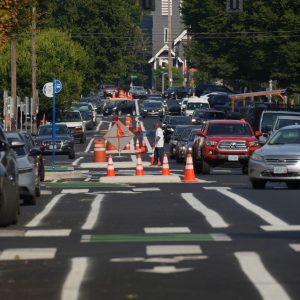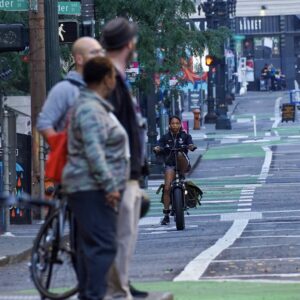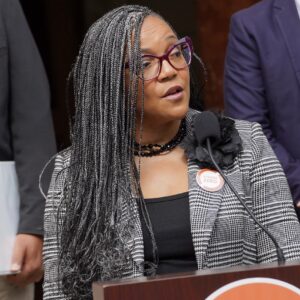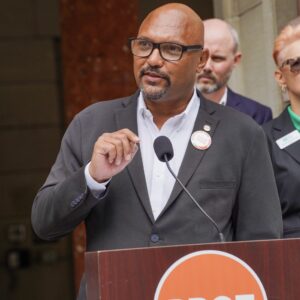
If you see city construction crews tearing up the bike lane on SW Broadway through downtown, don’t fear. They are not removing the protected bike lanes so many riders depend on for their safety every day. The work is part of an expected project from the Portland Bureau of Transportation to install new loading zone platforms.
If you recall from our coverage back in late September, before the big Broadway bike lane kerfluffle, PBOT was talking to managers and operators of hotels along the street about how to mitigate safety concerns voiced by valet staff, guests, and road users. As early as March 2023, PBOT staff told hotel operators they could receive the same type of loading platform in front of their business that the city had already installed in front of Arlene Schnitzer Concert Hall. The platforms raise the bike lane to sidewalk level, include green color for added visibility, and provide easier access to business entrances for people who park adjacent to the bike lane. The combination of the ramp, along with more robust signage and pavement markings increase awareness of the potential conflict zone for all users: valet staff, hotel guests, and bicycle riders.
PBOT announced on Monday they’ve begun construction on three new platforms. At a cost of about $90,000 each, they’ll be installed in front of the Benson (SW Oak), Heathman (SW Salmon), and Vance (SW Columbia) hotels. Each location should take about two weeks to build and you should expect a work zone environment as you cycle through. PBOT hopes to button up construction by mid-March. Final pavement markings won’t be done until spring because crews need dryer, warmer weather to install the materials.
In addition to building these platforms, PBOT said back in September they would release an evaluation of issues on SW Broadway and proposed upgrades that reflect the concerns from the public and business operators Commissioner Mingus Mapps and PBOT Director Millicent Williams used as justification for their planned changes. That evaluation would come with public outreach so a true, community-wide conversation could be had about how to improve SW Broadway. Three new signal upgrades at SW Oak, Taylor and Jefferson to separate bicycle through traffic from right-turning cars were also promised.
According to PBOT Public Information Officer Dylan Rivera, the evaluation report is ongoing. PBOT staff have prepared concepts and have presented them at the Central City in Motion Workin Group on October 18th (and the Downtown Neighborhood Association). The draft “hardening concept” shows concrete medians and protected corners throughout the corridor between NW Hoyt and SW Clay. Rivera says more public engagement is planned once they secure funding. As for the promised bike signals at Oak, Taylor and Jefferson, Rivera says two of them (Taylor and Jefferson) will be bundled with the upcoming SW 4th Avenue bikeway project slated to break ground this spring. PBOT still hasn’t found the funding to install the third signal (at SW Oak).
Learn more:






Thanks for reading.
BikePortland has served this community with independent community journalism since 2005. We rely on subscriptions from readers like you to survive. Your financial support is vital in keeping this valuable resource alive and well.
Please subscribe today to strengthen and expand our work.
Glad to see it. Last summer can’t have been the highest time for morale at PBOT and I really appreciate the staff who continued to push for making Broadway better rather than worse in order to address some legitimate complaints.
Phenomenal. This was always an option. From what I understand, this is what PBOT experts wanted to do in the first place.
Are the hotels going to pay for it?
According to PBOT’s high crash network page, Broadway (SW–NE) has the highest rate of bicycle crashes causing injury of any street in the city (but not cyclist deaths). Sidewalk-level bike lanes and raised crosswalks should be standard along the entire route. NE Broadway should be converted back to a regular two-way street from the drag strip it currently exists as.
I rode SW Broadway today and rode around the construction zone by the Vance Hotel.
I don’t love the ramp in front of the Schnitz b/c it’s a tad steep; the one being built in front of the Vance looks broader and maybe won’t be as steep.
After the fiasco last year where Director Williams came within days of ripping out that lane, I would say that anything that makes it harder to rip out that lane is important to do. Political whiplash should not dictate our transportation priorities.
This is a cool project. I’ve been going by the Vance Hotel for a long time. I love the Broadway bike lane but the curb extensions on Columbia and Clay shouldn’t have been constructed….alternatively, they could have been ped refuge isalnds (with a street level bike lane).
From the standpoint of separating bike and auto traffic, I understand the design benefits to safety of using these platforms. However as a cyclist, I am not a fan of either the protected bike lane which hides cyclists to right turning cars, or the loading platforms which are awkward to ride over and often have pedestrians just hanging out there, oblivious to traffic.
I wish culturally it was possible to actually share the traffic lanes with cars in this area which shouldn’t have speeds exceeding 20 mph.. but I do know better that there isn’t the respect or regard for other humans in sufficient quantity to make that workable, unfortunately.
Even if all motorists drove cautiously and respectfully, obeying traffic regulations to the letter, should we expect an elderly person on a mobility scooter to “share the road” with freight trucks and monstrous SUVs that are literally designed to be as intimidating as possible? How about a young mother pedaling a cargo bike with small children in it? My point is that culture by itself is unlikely to fix the (literal) power disparity between different types of road users.
Where exactly does the B’way protected lane hide cyclists from right-turning cars? Which intersections?
I rode there yesterday and I think every intersection with a right turn is well daylighted, esp the one down the hill by the Vance Hotel, which now has its own bike signal.
I’m usually not a big fan of so-called protected bike lanes, largely b/c of how poorly they are maintained. But the B’way protected lane is a really good one and needs to remain – and continue to be improved.
Hard to believe Director Williams was just a day away from ripping it out before JM led the pushback that saved it.
The places I most often get a near right-hook are southbound between glisan and burnside, and south of pioneer square at Taylor or clay. In most cases it’s when I’m moving at or near the speed of traffic and drivers forget I’m there and can’t see me through the parked cars very well.
I just don’t see how truly sharing the lane could ever work without inevitably frustrating drivers, even with the best of culture. Most of the cyclists most of the time are going to be going a max speed below 20mph, so even if drivers never exceeded that, they’d have to be in the mindset that most likely they’ll get behind a cyclist going 10 or fewer MPH. Or alternating between 10 and 15 or so depending on grade. In a cargo bike, well below 10mph. I just don’t see how it would work.
But maybe it does work some places. I don’t know. If it’s very busy I think people expect to go slow and constantly watch out, but this area just isn’t that bustling (a separate problem).
I just don’t see how truly sharing the lane could ever work without inevitably frustrating drivers
Yes, but I don’t believe that. What actually happens is there is not enough room and the driver either sits behind getting madder, or passes unsafely. I’ve been on the road before, this isn’t my first time out. And the behavior is just so common I don’t know if it will ever change. The problem is having a built environment that says cars are the important mode of transportation, and everything else is in the way.
I’ll pretty much ride everywhere (even on Powell for short stretches). Some people seem to have a lot of conflicts with drivers, but for whatever reason, I don’t. I certainly have been close-passed, but it’s rare. I’m sorry that it happens so much to you, because I agree that it sucks.